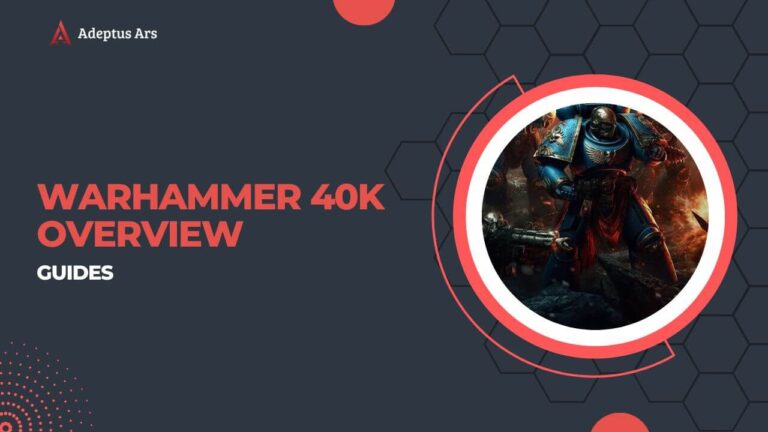What is Warhammer 40K?
Warhammer 40,000 (commonly known as Warhammer 40K) is a tabletop miniature wargame developed by Games Workshop.
It is set in a bleak future where humanity has expanded across the cosmos and is fighting an endless battle for existence against alien races and supernatural beings.
Warhammer 40k is a tabletop strategy game where players collect, paint and battle with armies of miniature models.
It involves using rulebooks, tape measures, and plenty of dice to orchestrate battles across a table decked out with miniature terrain. It’s a blend of strategy, creativity, and a bit of luck, making every game an engaging experience.
Why is Warhammer 40,000 so Popular?
Warhammer 40K’s immense popularity can be attributed to its richly detailed universe teeming with diverse factions, offering a blend of sophisticated strategic gameplay and the rewarding hobby of collecting and painting miniatures.
This game stands out for its dynamic evolution and the robust community it fosters, making it appealing to a broad spectrum of enthusiasts, from competitive gamers to hobbyists.
Adding to its allure, numerous wargaming clubs host gatherings in game stores and community spaces, welcoming players into the world of Warhammer 40,000 and other tabletop games.
These clubs serve as fantastic venues for connecting with fellow enthusiasts, offering a supportive environment for newcomers to learn the ropes.
Games Workshop’s official Warhammer stores contribute to this welcoming atmosphere by organizing demo games for those just starting their journey into the hobby.
While there’s a segment of the player base that dives deep into the competitive aspects of Warhammer 40K, meticulously optimizing their armies and honing their strategies for tournaments, the majority are there for the sheer enjoyment.
This inclusive and multifaceted approach to gaming is key to why Warhammer 40K continues to captivate and grow its devoted following.
The Warhammer 40k Tabletop Game
Embarking on your Warhammer 40,000 experience is like entering a huge galaxy of eternal battle and dark fantasy. Given the intricacy of the game’s mythology and the variety of miniatures, newbies may find the beginning to be both fascinating and daunting.
Starting with Warhammer 40,000
Beginners are typically urged to purchase a starting set, which includes everything they need to play: miniatures for two armies, dice, rulers, and a simplified rulebook.
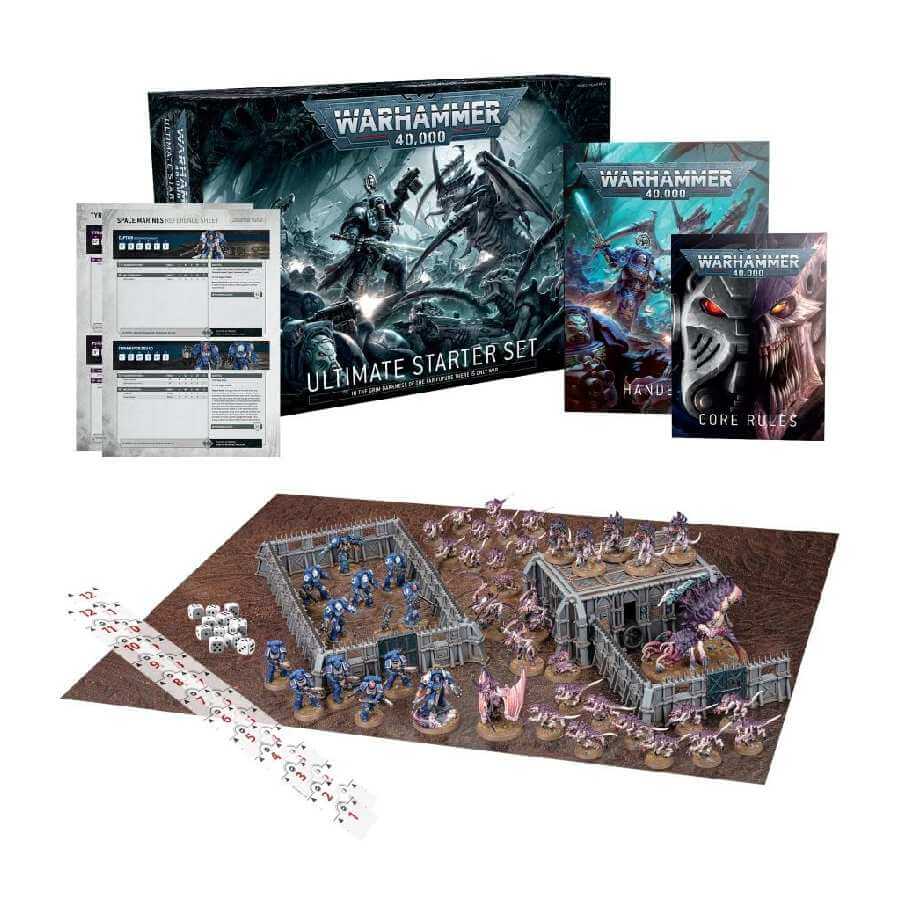
These sets are intended to teach the fundamentals of gameplay and miniature assembly/painting in an understandable and engaging manner.
Choosing an army that appeals to you artistically and conceptually is critical, as you’ll be spending a lot of time creating, painting, and planning with these units.
If you want to play the complete version of the game, or play competitively, things are getting a bit more complex.
Things You Need to Start Playing
Here’s what you’ll need to dive into this immersive wargame:
| Item | Description |
|---|---|
| Miniatures | Collection of miniatures to assemble and paint, forming your army. |
| Core Rulebook + Faction Codex | Essential guide to game mechanics, rules, and lore. Additionally your chosen faction’s Codex. |
| Dice | Used for gameplay; a large number of six-sided dice. |
| Measuring Tools | Tape measure or ruler for movement and range measurements. |
| Miniatures | Collection of miniatures to assemble and paint, forming your army. |
| Paints and Brushes | Tools for assembling and painting your miniatures, including paints and brushes. |
| A Place to Play | Space for playing, like a large table, often available at gaming stores or clubs. |
Warhammer 40K: The Armies
Warhammer 40K’s miniature armies are its heart and soul, each representing a distinct faction with its own lore, aesthetics, and gameplay style. From the disciplined columns of the Imperial Guard to the enigmatic alien T’au, the daemonic hordes of Chaos, and the ancient Necrons, each army provides a unique approach to play and explore the 40K universe.
Here’s a quick overview of the primary factions in the game:
- Space Marines – The genetically modified warriors of the Imperium, known for their versatility and strength.
- Chaos Space Marines – Space Marines who have sworn allegiance to the Chaos Gods, featuring demonic units and warp-based powers.
- Imperial Guard (Astra Militarum) – The vast human army of the Imperium, relying on numbers, tanks, and artillery.
- Orks – A war-loving and technologically crude race, known for their brute strength and unpredictable warfare.
- Eldar (Aeldari) – An ancient and highly psychic alien race, specializing in speed and advanced technology.
- Dark Eldar (Drukhari) – The sinister kin of the Eldar, focusing on fast attacks and cruel tactics.
- Necrons – An ancient race of skeletal robots, with advanced technology and strong resilience.
- Tyranids – A swarm-like alien race, focused on close combat and overwhelming numbers.
- Tau Empire – A technologically advanced race with a focus on ranged combat and allied alien races.
- Chaos Daemons – The entities of the Warp, featuring a mix of monstrous creatures and psychic powers.
- Genestealer Cults – A sneaky and subversive group, with a mix of human cultists and Tyranid hybrids.
- Adeptus Mechanicus – The tech-priests of Mars, specializing in advanced weaponry and robots.
- Sisters of Battle (Adepta Sororitas) – An all-female division of the Imperium’s Ecclesiarchy, with a focus on faith-based powers and flame weapons.
- Grey Knights – Daemon hunters of the Imperium, an elite Space Marine chapter specializing in psychic powers.
- Deathwatch – An elite Space Marine chapter specializing in hunting aliens, with members drawn from other Space Marine chapters.
- Harlequins – A mysterious troupe of Aeldari warriors, focusing on acrobatic combat and trickery.
- Custodes – The Emperor’s personal guard, known for their unmatched combat skills and golden armor.
- Imperial Knights – Piloted super-heavy walkers, allied with various factions, focusing on massive firepower and armor.
Warhammer 40,000: The Rules
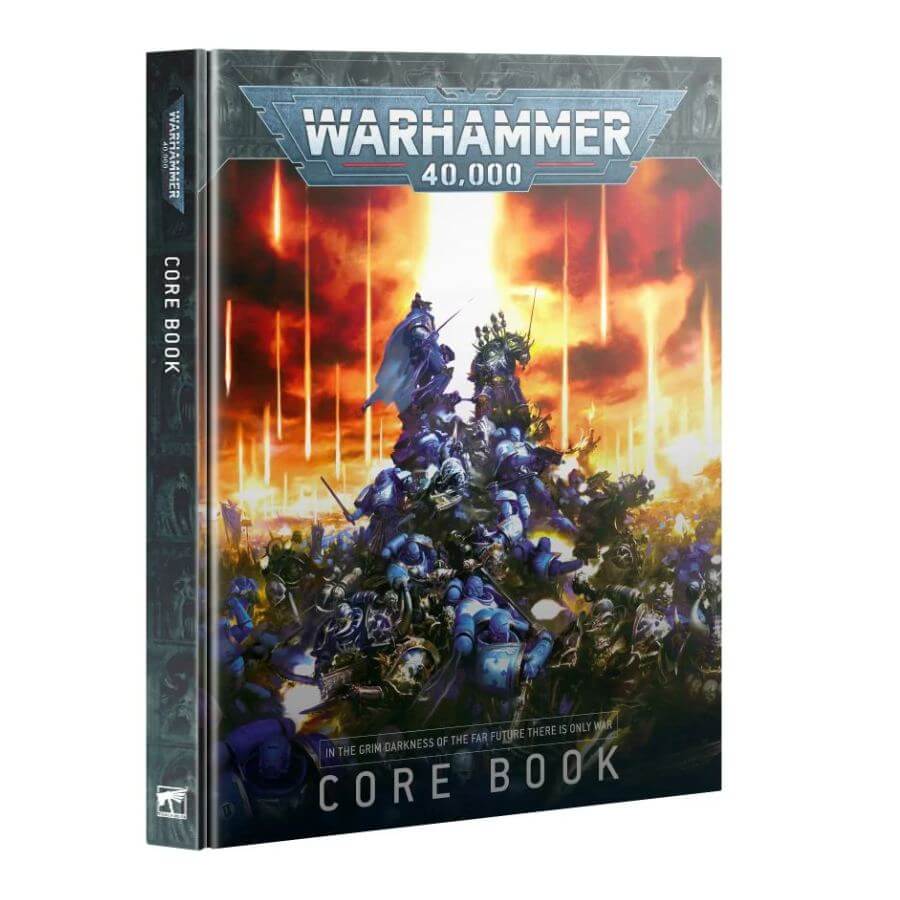
Warhammer 40K unfolds through a succession of battle rounds, mirroring the tumultuous and strategic nature of combat.
Each battle round breaks down into a series of specific phases, symbolizing various facets of the conflict. In the game’s 10th edition, these phases proceed in the following order:
| Phase | Description |
|---|---|
| Command Phase | Players gain command points and use abilities specific to this phase. |
| Movement Phase | Units move across the battlefield to position for attacks or objectives. |
| Shooting Phase | Units fire their ranged weapons at targets within line of sight and range. |
| Charge Phase | Units attempt to close in on the enemy for melee combat through charges. |
| Fight Phase | Engaged units fight in close combat using their melee weapons. |
Each phase plays a critical role in the strategy and flow of the game, guiding players through the steps of commanding armies, maneuvering units, engaging in ranged and melee combat, and seizing control of the battlefield.
Learn more about the game’s core rules from our Beginner’s Guide on How to Play 10th Edition.
Warhammer 40K Versions and Editions
Warhammer 40k’s editions mark the game’s evolution, introducing new rules and expanding the universe with each update.
The release of a new edition is typically a big deal in the Warhammer 40K community since it usually includes new miniatures, lore expansions, and revised codexes (army-specific rulebooks) that give the game new vitality.
| Edition | Year | Key Features |
|---|---|---|
| 1st | 1987 | Introduced Warhammer 40k, focused on narrative play |
| 2nd | 1993 | Refined rules, introduced the psychic phase |
| 3rd | 1998 | Streamlined gameplay, emphasized army codexes |
| 4th | 2004 | Updated rules for shooting and close combat |
| 5th | 2008 | Enhanced vehicle combat, battlefield terrain rules |
| 6th | 2012 | Introduced challenges in combat, overwatch fire |
| 7th | 2014 | Further refined psychic phase, detachments |
| 8th | 2017 | Overhauled rules for simplicity, introduced datasheets |
| 9th | 2020 | Improved balance, command points, and missions |
| 10th | 2023 | Removed Psychic Phase, stratagem sestrictions, simplified rules |
We are Now Playing Warhammer 40,000 10th Edition
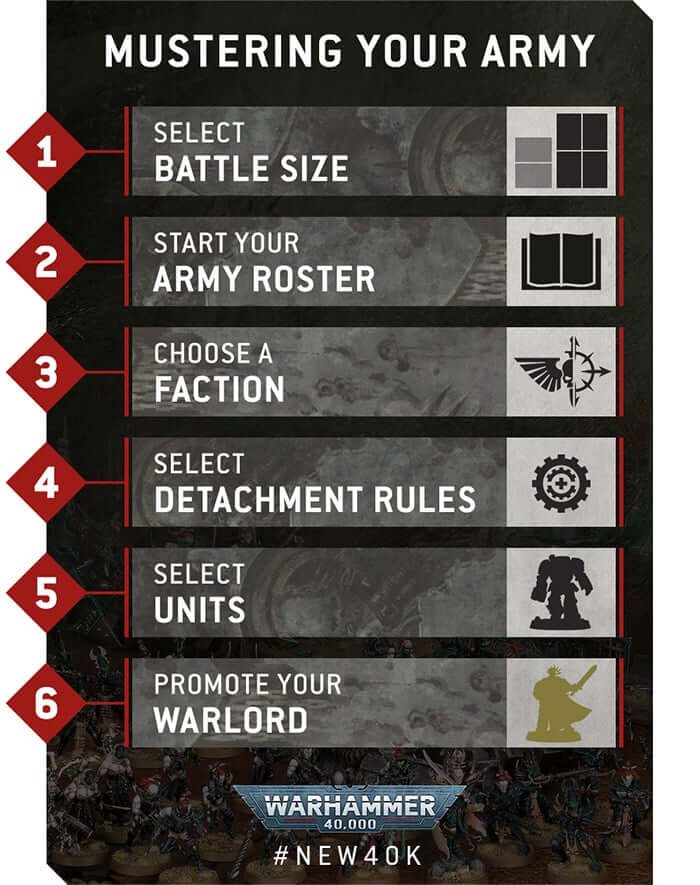
The newest edition of Warhammer 40k was released on Saturday, June 24 2023, with Games Workshop making most of the rules and army lists available in a free digital edition over the two weeks prior.
The 10th Edition of Warhammer 40,000, like its predecessors, introduces alterations and updates to the game’s rules, resulting in a more fluid and interesting gameplay experience:
- No More Psychic Phase: The Psychic Phase was removed, and psychic abilities are now integrated into other phases, such as movement or shooting, depending on their nature.
- Changes to Unit Stats: A new stat, objective control points, has been added to clarify a unit’s ability to control objectives, adding a new tactical layer to gameplay.
- Weapon Profiles Update: Weapon skill and ballistic skill are now included in weapon profiles, linking specific weapons to their users for clearer unit functions.
- Leadership Tests Overhauled: Leadership tests now require rolling two dice, with higher scores than the unit’s leadership value indicating failure. This affects actions like falling back or controlling objectives.
- Model Selection Rules: Limits on characters, epic heroes, and units in armies have been introduced, adding strategic choices to army building
Any many, many more. You can read about all the changes in our comprehensive guide to the 10th Edition.
New Warhammer 40K Codexes
Warhammer 40K Codexes are vital rulebooks that contain detailed information and rules for specific factions or armies in the game.
These books provide players with in-depth knowledge of their chosen faction, including its lore, units, unique abilities, and strategies.
Codexes are regularly updated to match the current edition of the game, ensuring balance and fairness in gameplay.
The 10th Edition already brought new Codexes for some of the factions, while others are still on the roadmap!
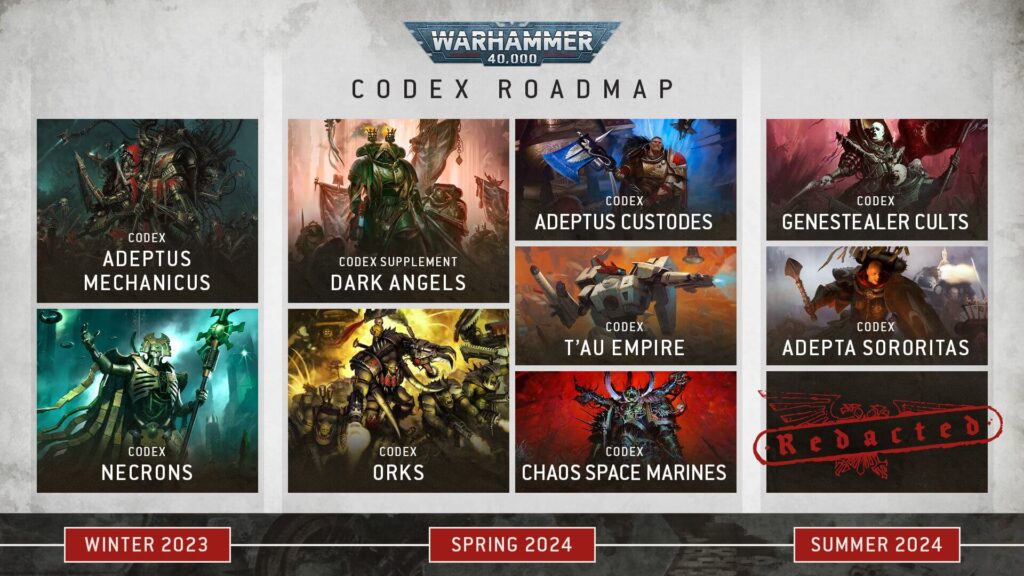
- Spaces Marines Codex
- Tyranids Codex
- Adeptus Mechanicus Codex
- Necrons Codex
- T’Au Empire Codex
- Orks Codex
- Dark Angels Codex Supplement
Origins of Warhammer 40K
Warhammer 40K made its way into the hearts and minds of tabletop players back in 1987. It’s the sci-fi counterpart to Warhammer Fantasy, which was already making ripples in the gaming world.
Warhammer 40K, developed by Games Workshop, offered something fresh and exciting: a dark, dystopian future dominated by violence.
The universe is a grimdark masterwork, full of different factions ranging from the noble but regimented Space Marines to the evil forces of Chaos, each with their own rich narrative and backstory.
Rogue Trader
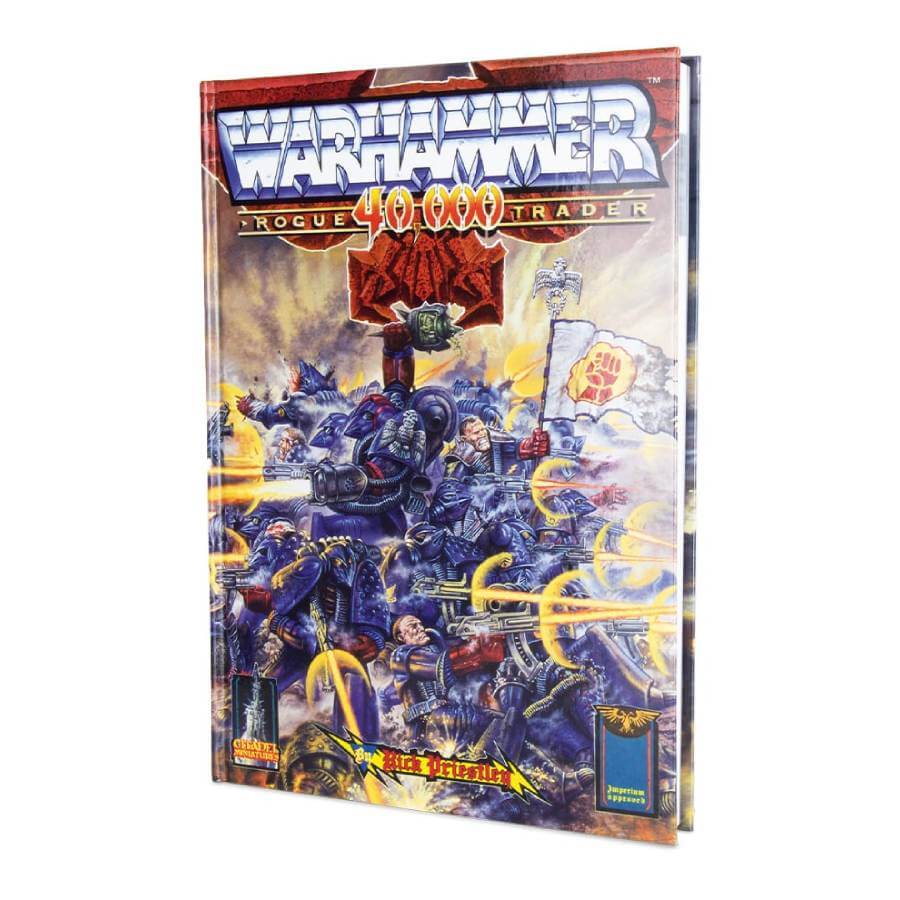
We can’t talk about the roots of W40K without including “Rogue Trader.” The first edition of Warhammer 40K started out as this. Consider this the foundation upon which the massive empire of Warhammer 40K was formed.
“Rogue Trader” exposed players to a wild, lawless galaxy ready for exploration, conquest, and, of course, trading. The game was far more open-ended than its subsequent editions, with a strong emphasis on story campaigns and role-playing components.
Players could be mercenary commanders, extraterrestrial emissaries, or the eponymous Rogue Traders—adventurous adventurers seeking money and fame throughout the stars.
Why is it called Warhammer 40K?
So, why is it called “Warhammer 40,000”? The “Warhammer” component refers back to its fantasy beginnings, indicating the brand’s identity and epic scope of conflict.
The “40,000” section is when things get interesting. It alludes to the game’s setting in the 41st millennium (which corresponds to the years 40,000-41,000).
This far-future scenario allows for a cosmos in which technology and mysticism coexist, human civilization is spread over the galaxy but on the verge of extinction, and violence is truly unfathomable. It’s a backdrop that promises countless stories of courage, betrayal, and, most importantly, cosmic war.
Warhammer 40K vs Warhammer the Old World vs Warhammer Age of Sigmar
Warhammer 40K, Warhammer: The Old World, and Warhammer Age of Sigmar are foundations of the huge Warhammer universe, each with its own setting and gaming experience.
Warhammer 40K immerses players in a dark and dismal future in which humanity faces alien dangers, heretical cults, and the corrupting power of Chaos. With its emphasis on futuristic technology, psychic powers, and dismal storytelling, immerses players in a universe of limitless possibilities and grim realities.
Warhammer the Old World
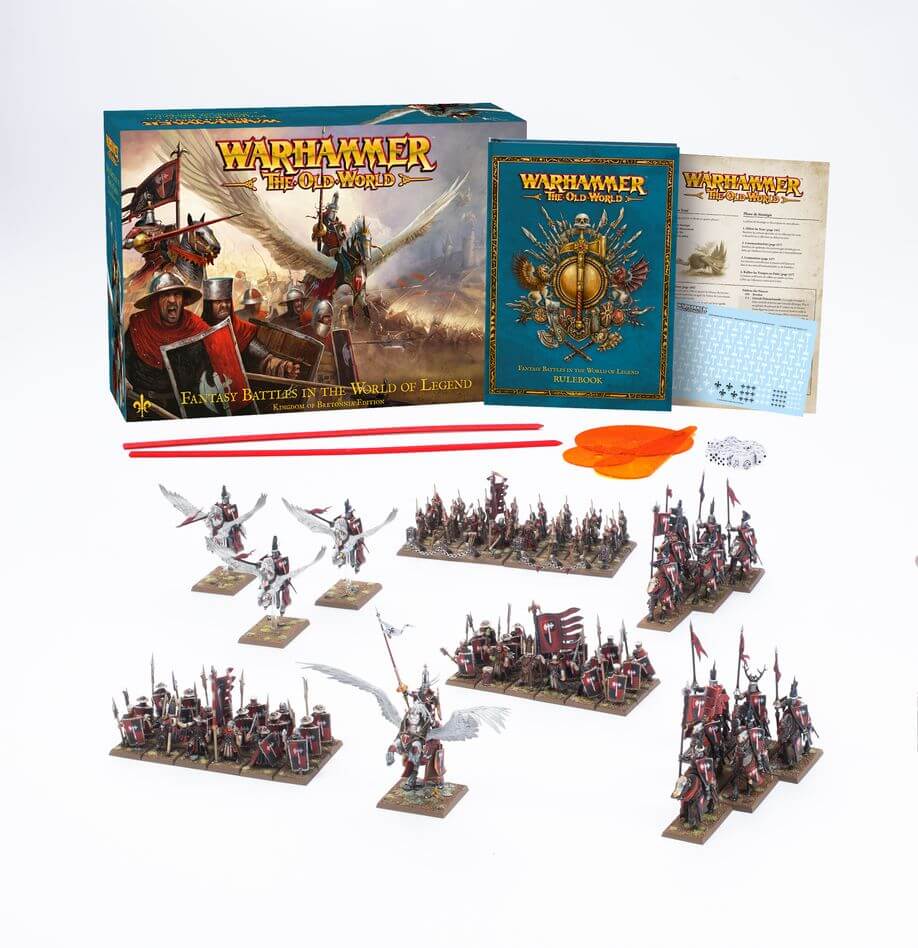
In contrast, Warhammer: The Old World immerses players in a high fantasy world evocative of Earth’s medieval past, where knights, monsters, and magic clash in epic conflicts.
From the noble knights of Bretonnia to the clever skaven lurking in the shadows, Warhammer: The Old World provides a rich tapestry of fantastical monsters, old empires, and legendary heroes to discover.
With its rich narrative and intricate history, Warhammer: The Old universe allows players to embark on epic journeys and influence the fate of a magical universe.
Warhammer Age of Sigmar
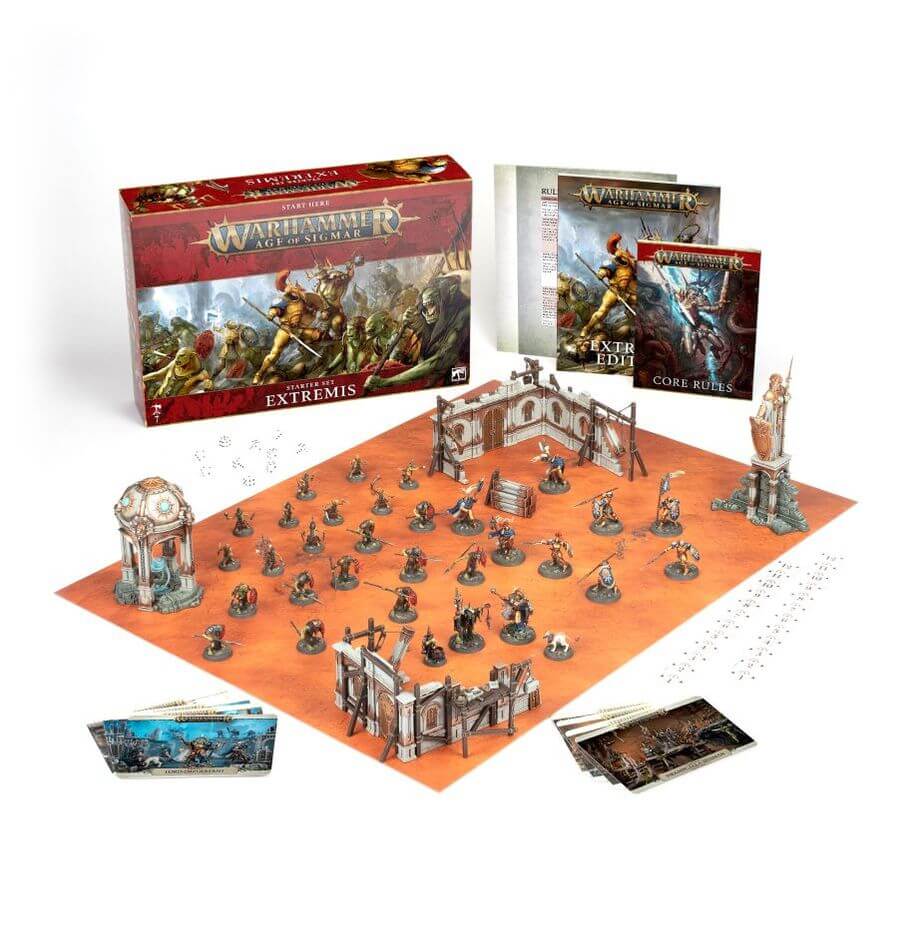
Warhammer Age of Sigmar brings together the deep darkness of Warhammer 40K and the epic fantasy of Warhammer: The Old World, bringing players to the Mortal Realms, a place of mythic proportions.
Following the horrific events of the End Times, Warhammer Age of Sigmar was released as a reworking of the traditional Warhammer Fantasy Battles, infusing the Mortal Realms with magic and a broad range of races and groups.
From the celestial soldiers of the Stormcast Eternals to the enigmatic forces of Chaos, Warhammer Age of Sigmar allows players to influence the fate of the Mortal Realms through epic battles of cosmic proportions.
Want to learn more about the differences between the three games?
Warhammer 40,000 Tabletop Spin-offs
Warhammer 40K’s universe is so big and deep that it has inspired multiple successful tabletop spin-offs, each of which provides a unique approach to explore the grim future of the 41st millennium.
Let’s look at a handful of these spinoffs:
Combat Patrol Games
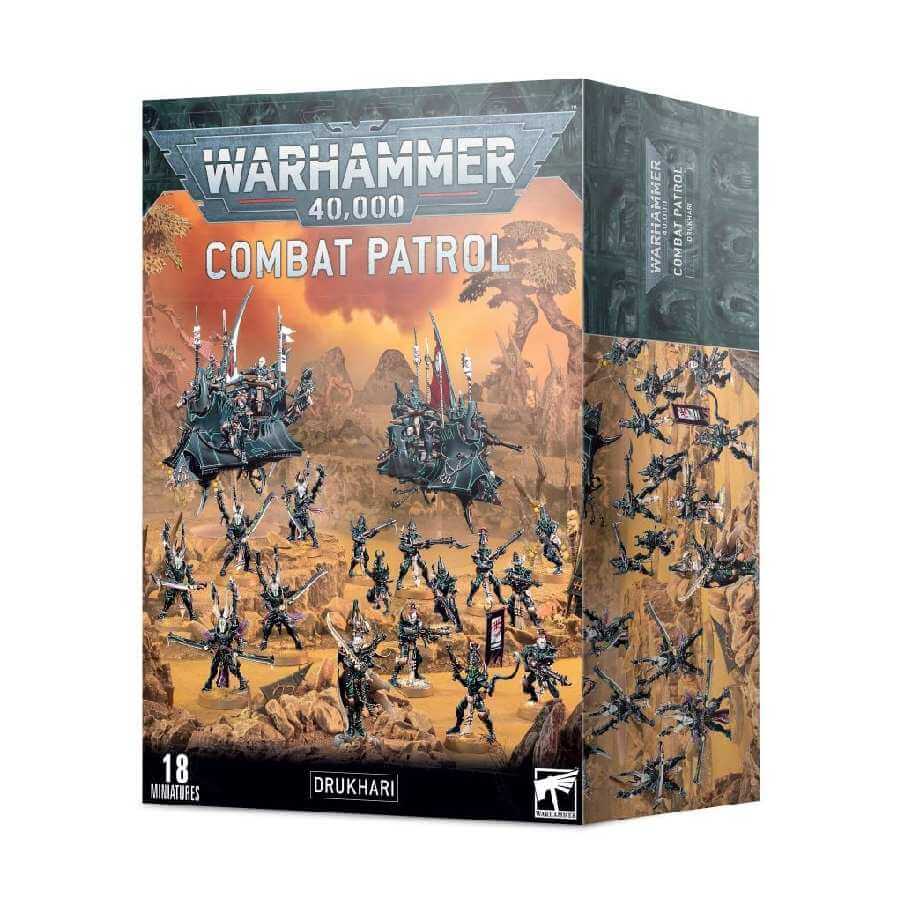
Combat Patrol is intended for players who desire to engage in smaller, faster fights without sacrificing the depth and strategy that Warhammer 40K is known for.
It’s ideal for both newbies receiving their first taste of the 41st millennium and veterans seeking a fast-paced game.
Combat Patrol games are fought with smaller armies, often around 500 points, giving it a more accessible way to start a new army or deploy a force in less time than a full-scale conflict.
Kill Team Games
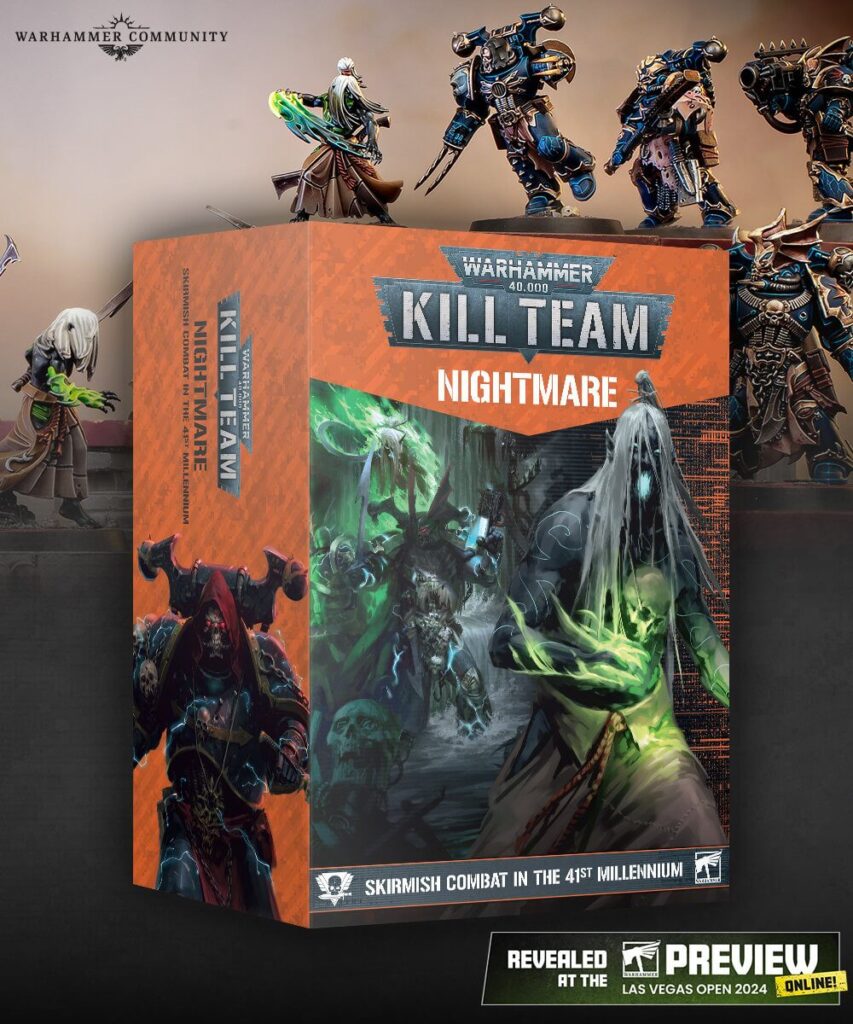
Kill Team refines the Warhammer 40K experience even further, focusing on conflicts between tiny squads of troops rather than entire armies.
This spin-off focuses on stealth, tactics, and individual heroism, with each model operating autonomously rather than as part of a larger force.
It’s an excellent way to delve deeply into the narrative of your favorite faction, as you may customize and build your squad over time.
Kill Team takes a more intimate, narrative-driven approach to warfare, allowing each soldier to be a hero with their own tale.
Necromunda
Necromunda sends players to the Imperium’s hive cities, with a concentration on gang warfare in a dystopian urban jungle.
It’s a game of strategy, territorial control, and gang evolution in which players control a gang vying for dominance in the underhive.
Necromunda stands out for its sophisticated campaign structure, which allows gangs to gain experience, sustain injuries, and obtain new equipment over time.
The game delves deeply into the Warhammer 40K universe’s lore, covering daily life and struggles within hive cities, resulting in a complex, narrative-driven experience.
The W40K Franchises
Warhammer 40,000 is a tabletop gaming behemoth whose influence extends far beyond miniatures and gaming tables. The IP (Intellectual Property) has been ingeniously converted into a variety of mediums, expanding the grimdark realm for followers worldwide.
Books and Novels
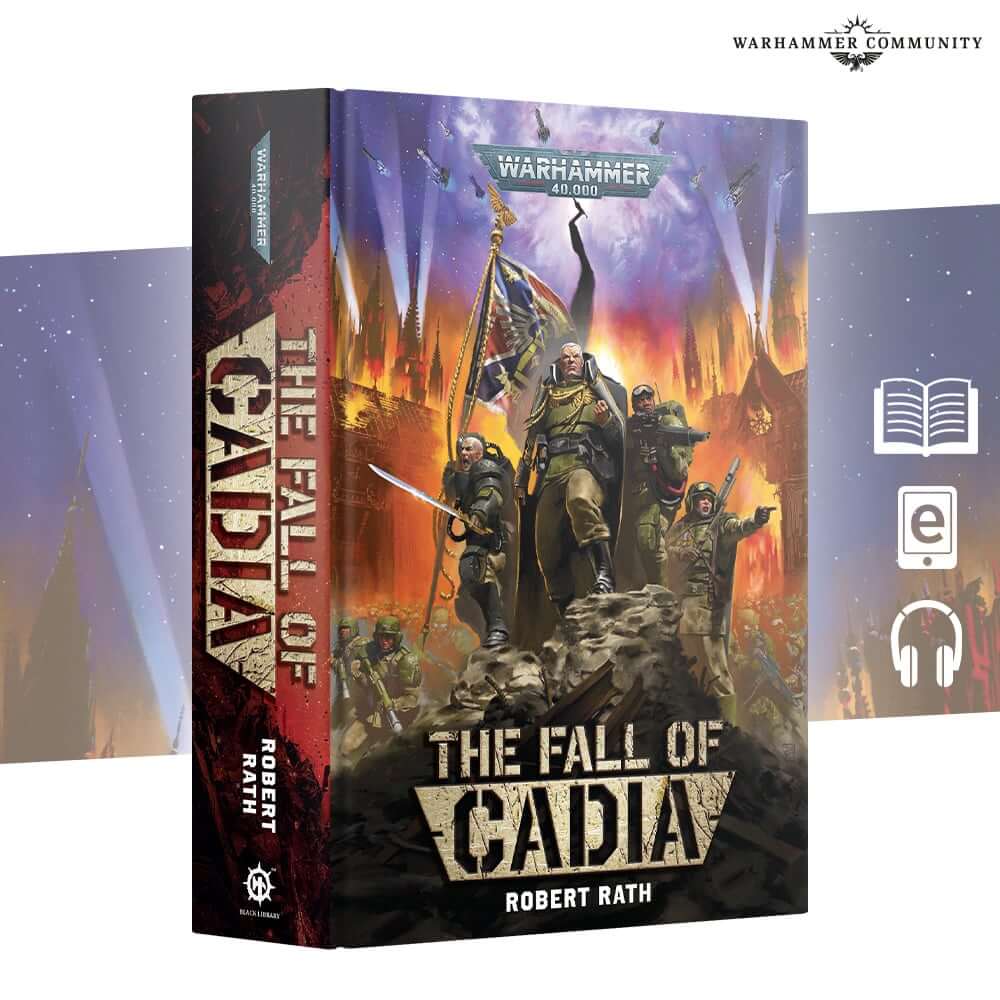
Black Library, Games Workshop’s publishing arm, creates a diverse selection of novels, novellas, and short stories set in the Warhammer 40K universe, delving into the lore and developing the backstory of its characters and factions.
- Horus Heresy Series: A cornerstone series that delves into the lore of the Horus Heresy, a pivotal galaxy-spanning civil war that predates the current 40K timeline.
- Gaunt’s Ghosts: A series by Dan Abnett following the exploits of the Imperial Guard regiment known as the Tanith First-and-Only.
- Eisenhorn Series: Also by Dan Abnett, this series follows Inquisitor Gregor Eisenhorn as he battles heretics and demons within the Imperium.
Comics and Graphic Novels
The Warhammer 40K universe has been explored through comic books and graphic novels, which bring the galaxy’s visual splendor to life on the page.
- Marneus Calgar: A series focusing on the Ultramarines’ Chapter Master, exploring his origins and battles.
- Blood and Thunder: Follows the Orks in their typical brutish and humorous manner through the galaxy.
Video Games
The Warhammer 40K universe has inspired a diverse range of video games, including real-time strategy and first-person shooters.
- Dawn of War Series: A critically acclaimed real-time strategy series developed by Relic Entertainment, allowing players to command the armies of different factions in the 40K universe.
- Space Marine: An action-packed third-person shooter that puts you in the boots of a Space Marine fighting against Orks and Chaos forces.
- Battlefleet Gothic: Armada: A real-time strategy game that focuses on the space battles of the 40K universe, featuring various fleets from the sprawling factions of the galaxy.
Check our ultimate guide to the Warhammer 40K Games you should play in 2024!
Action Figures
Companies such as JOYTOY and McFarlane Toys have entered the fray, putting the rich detail and enormous mythology of the 40K universe into the hands of fans in a completely new format.
- JOYTOY Action Figures: They have released figures such as Space Marine chapters (Ultramarines, Blood Angels, Dark Angels, etc.), Chaos Space Marines, and even the Adepta Sororitas (Sisters of Battle). Each figure typically comes with a range of weapons and accessories, allowing for dynamic poses and display options.
- McFarlane Toys Action Figures: They’ve launched figures from several iconic factions, including Space Marines in various chapter colors (like the Ultramarines Intercessor, Blood Angels Hellblaster, and more), as well as characters from the Necrons. These figures are known for their size, detail, and paintwork, appealing to collectors and fans who appreciate high-quality merchandise.
Board Games
There have been several board games set in the Warhammer 40K universe that provide condensed and focused gameplay experiences.
- Space Hulk: A classic board game that pits Space Marine Terminators against Genestealers aboard the derelict spacecraft known as Space Hulks.
- Warhammer 40,000: Conquest: A card game where players control factions vying for dominance over various planets.
Role-Playing Games
Role-playing games set in the Warhammer 40K universe allow players to create their own characters and embark on missions within the grimdark setting.
- Dark Heresy: Players take on the roles of Inquisitorial agents, rooting out heresy and alien threats to the Imperium.
- Rogue Trader: Focuses on the adventures of Rogue Traders and their retinues as they explore uncharted space.
Merchandise
From garments to artwork and beyond, the Warhammer 40K trademark has been applied to a wide range of items, allowing fans to demonstrate their support for their favorite factions.
- T-shirts, hoodies, and apparel featuring iconic imagery and quotes from the 40K universe.
- Statues and collectibles of popular characters and units, crafted in stunning detail.
Movies and Shows
While the brand is best known for its board games, novels, and video games, there has been an increasing interest in turning its rich lore and epic storytelling into films or television shows.
- “Ultramarines: A Warhammer 40,000 Movie”: It was a direct-to-DVD feature that explored the story of the Ultramarines, a loyalist Space Marine Chapter.
- “Eisenhorn”: This series is set to adapt the Eisenhorn trilogy by Dan Abnett, one of the most popular novel series set in the Warhammer 40,000 universe. The books follow Inquisitor Gregor Eisenhorn as he battles heretics, aliens, and demons to protect humanity.
- Upcoming Amazon Prime Series with Henry Cavill: Henry Cavill, known for his roles in “The Witcher” and as Superman in the DC Extended Universe, was set to star in and executive produce a Warhammer 40,000 series on Amazon Prime.
- WarhammerTV Shows: Warhammer+ is a subscription service that includes access to animated series set in both the Warhammer 40,000 and Warhammer Age of Sigmar universes. Several series were in production or planned, aiming to explore various facets of the lore through animation.
- “Hammer and Bolter”: This series is a collection of anthology stories that explore various corners of the Warhammer 40,000 universe.
- “Angels of Death”: This series focuses on the Blood Angels, a storied Space Marine chapter known for their martial prowess as well as their tragic flaw – the Black Rage.
- “Pariah Nexus”: This show, like others on the platform, dives into the extensive lore of the Warhammer 40,000 universe, focusing on the dark and mysterious region known as the Pariah Nexus.
The Warhammer 40K Lore
The universe is defined by its “grimdark” concept, which comes from the game’s slogan, “In the grim darkness of the far future, there is only war.” It’s a place where moral ambiguity reigns and the distinction between good and evil is frequently muddled.
At its center is the Imperium of Man, a theocratic empire spanning millions of worlds, ruled by the God-Emperor, who, despite his immortality and power, sits inert on the Golden Throne, scarcely alive.
Humanity is besieged from all sides by hostile aliens and wicked supernatural beings from the Warp, a dimension of chaos and psychic energy.
The W40K lore is rich and expansive, offering stories of individual heroes, planet-spanning campaigns, and the eternal struggle of the Imperium to hold back the tide of darkness threatening to engulf humanity.
The “Heroes” of Warhammer 40K
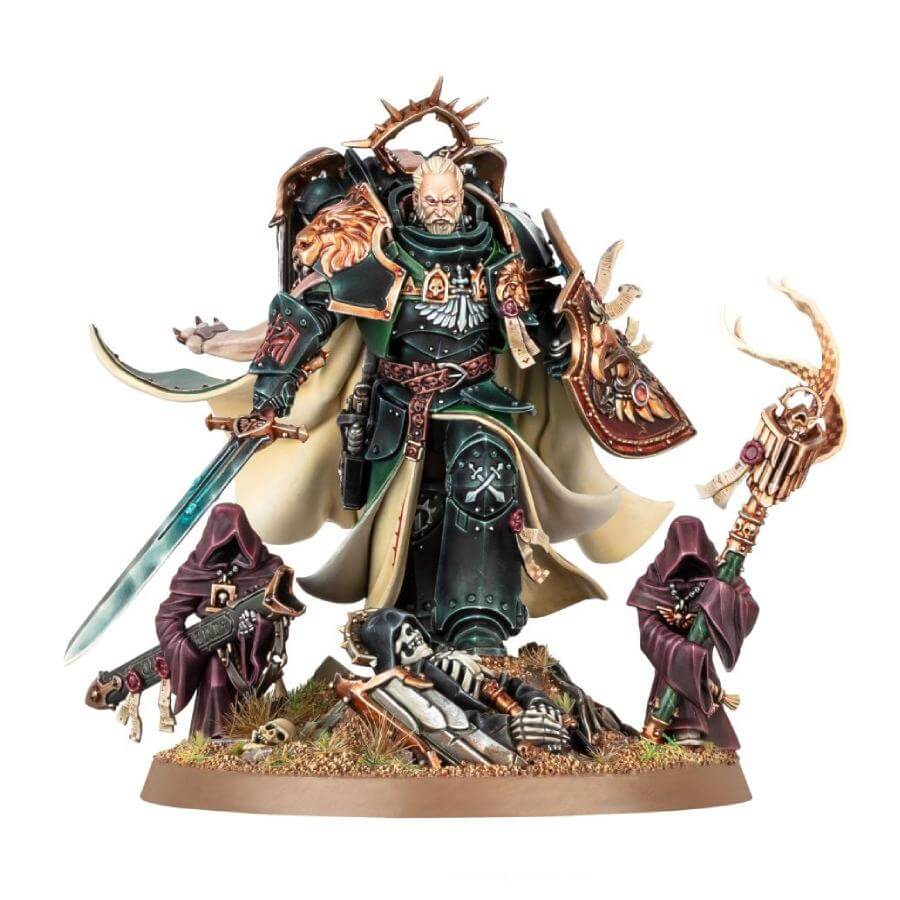
In the vast and complex universe of Warhammer 40K, the term “heroes” can vary widely depending on the perspective and allegiance within the lore.
Nevertheless, here are some of the most notable characters from various factions:
Imperium of Man
- Roboute Guilliman: The Primarch of the Ultramarines, resurrected in the 41st Millennium to lead the Imperium as the Lord Commander.
- Marneus Calgar: The Chapter Master of the Ultramarines, known for his tactical genius and physical prowess.
- Lion El’Jonson: The Primarch of the Dark Angels, one of the original twenty Primarchs created by the Emperor.
- Saint Celestine: A living saint of the Adepta Sororitas, believed to be the embodiment of the Emperor’s will, resurrecting from death to smite the Imperium’s foes.
Chaos
- Abaddon the Despoiler: The Warmaster of Chaos, leading the Black Crusades against the Imperium, a direct challenge to its supremacy.
- Magnus the Red: The Primarch of the Thousand Sons, now a Daemon Prince of Tzeentch, wielding formidable psychic powers.
- Mortarion: The Primarch of the Death Guard, transformed into a Daemon Prince of Nurgle, the Chaos God of Decay and Disease.
- Angron: The Primarch of the World Eaters, now a Daemon Prince of Khorne, the Chaos God of Blood and War. Angron’s wrath is unmatched, his rage eternal.
Xenos
- Farseer Eldrad Ulthran: One of the most powerful and wise Farseers of the Eldar, playing a crucial role in the survival of his race.
- Ghazghkull Mag Uruk Thraka: A legendary Ork Warboss who is leading a massive Waaagh! to conquer the galaxy.
- Imotekh the Stormlord: A Phaeron of the Necron Sautekh Dynasty, known for his strategic acumen and desire to restore Necron dominion over the galaxy.
Adeptus Mechanicus
- Belisarius Cawl: A genius Archmagos of the Adeptus Mechanicus, instrumental in the development of the Primaris Space Marines.
Quick Answers:
What does the 40K Mean in Warhammer 40K?
In Warhammer 40k, “40k” refers to the setting’s expansive timeline, specifically denoting the 41st Millennium. This period serves as the backdrop for the game’s rich tapestry of stories and conflicts, showcasing a universe teeming with diverse factions, epic battles, and ancient mysteries.
Can Warhammer 40K be Played Solo?
Absolutely! While Warhammer 40K is primarily known as a tabletop wargame played between two or more players, it can indeed be enjoyed solo. Many enthusiasts engage in solo play by controlling both sides of the battlefield, effectively acting as both strategist and opponent, just like in chess.
Can you play Warhammer 40K with Age of Sigmar
No. While Warhammer 40K and Age of Sigmar are both immersive tabletop wargames produced by Games Workshop, they are distinct universes with separate rule sets, miniatures, and settings. Consequently, they are not designed to be directly compatible for gameplay crossover.
Can You Play Warhammer 40K Tabletop Online?
Yes, a Warhammer 40K tabletop game can be simulated online through various digital platforms and tools. One popular method is through virtual tabletop platforms like Tabletop Simulator, Vassal, or Roll20, where players can recreate the tabletop experience digitally. Remember though, these are not Games Workshop developed games, hence the rules, stratagems and points might not be up to date!

